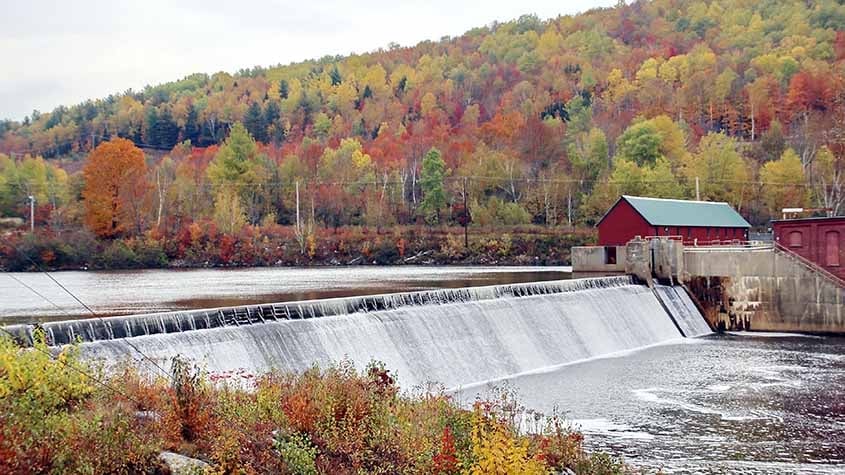Hydropower Basics
Hydropower—energy created from fresh, moving water—is the world's oldest form of renewable energy.
Over 2,000 years ago, the ancient Greeks used the power in rivers and streams to rotate wooden wheels and crush grain to make bread. Today, we still use this water power to generate clean, affordable electricity for everything from factories (that grind far more grain than the Greeks did) to our ovens that let us bake our bread at home.
What Is Hydropower?
Humans have used water power for centuries. But we didn't start making hydropower—electricity from our rivers, streams, and lakes—until just over 100 years ago, not too long after Thomas Edison invented electric power. Today, instead of using large, wooden wheels, we use propeller-like devices called turbines, which spin as water rushes through them, generating electricity. But hydropower has a secret power: It can also store huge amounts of renewable energy to use when other sources dry up.
Right now, hydropower provides about 7% of the United States' electricity and about 40% of our renewable energy. And almost every state uses it. The oldest form of renewable energy, it's also one of the most affordable and can provide a clean, sustainable, and reliable way to power our lives for centuries to come.

In the past, we often created hydropower with large dams, but today's structures are typically far smaller, which means they can better protect fish and other critical wildlife and plants that depend on these waters to survive. Photo from Mark König, Unsplash
How Does Hydropower Work?
Most of the country's hydropower facilities were built in lakes, streams, and rivers decades ago. They often used large dams that block the water's flow, creating a pool of water above the structure. One or more pipes give that pooled water a path to surge downhill. And as the water rushes through those pipes, it spins a turbine, which runs a generator that sends clean electricity to your home.
Today, most newly constructed hydropower facilities are far smaller and use new techniques to better protect the wildlife and plants that rely on naturally flowing waterways. Fish, for example, must migrate upstream to feed and mate. To help them navigate around our dams, we build fish ladders, so they can climb over the top and swim on. Or we don't block their path at all; some new hydropower facilities divert part of a river or stream into a separate channel. That way, the river and its ecosystem can race on, undisturbed, while we generate power off to the side.
Some hydropower facilities don't just generate power; they store it in the largest "batteries" on Earth. So-called pumped storage hydropower—also known as water batteries—can hold huge amounts of renewable energy for months at a time. This storage is very important. Solar energy and wind power only create electricity when the sun shines and winds blow, but water batteries can store excess energy that can be used at night or during gentle breezes. In the United States, they can store up to 553 gigawatt-hours of energy. That could power the entire country's video gaming for about a week.
What Makes Hydropower So Great?
Hydropower costs less than most other energy sources, making it an affordable source of renewable energy. Except during periods of extreme drought, we can count on water to flow day and night and all year round. And this consistency is critical if we want to rely purely on clean energy sources, such as solar energy and wind power, which can come and go.
New hydropower technologies keep getting better, too. They make it easier to build new facilities without too much disruption to the local environment. And they help cut construction costs, which could make hydropower even more affordable, potentially reducing energy bills across the country.
Hydropower facilities can also control how much water flows through their turbines and, therefore, how much energy they produce and when. That way, hydropower can fill energy gaps to ensure communities always get the power they need—or restore it. When ice storms, wildfires, or even hackers stop the electric grid from lighting up our lives, hydropower can help. In almost half of all blackouts, it's water that turns the lights back on. Losing power during a heat wave or at a hospital is not just inconvenient; it can be dangerous. Hydropower can save lives.
What Else Can Hydropower Do?
Water housed in hydropower facilities can be used to water crops, put out wildfires, or provide clean drinking water to local communities.
In some areas, such as the drier Western states, the warming climate is likely to cause more droughts, which could threaten water supplies. Because hydropower facilities can absorb and store extra water, they can help communities manage their supplies. In the Northeast, on the other hand, climate change is likely to cause more flooding. Hydropower can help with that, too. Its reservoirs can capture dangerous run-off, preventing those waters from surging into towns and cities where it can threaten properties and lives.
Additional Resources
For more information about hydropower, browse the following resources.
NREL's Hydropower Research – news and updates about NREL's hydropower studies and innovations
An Examination of the Hydropower Licensing and Federal Authorization Process, NREL Technical Report (2021)
Hydropower Fact Sheet, U.S. Department of Energy's Water Power Technologies Office (2021)
Hydropower Basics
U.S. Department of Energy's Office of Energy Efficiency and Renewable Energy
How Hydropower Works
U.S. Department of Energy's Office of Energy Efficiency and Renewable Energy
REDi Island: Renewable Energy Discovery Island—a virtual world powered entirely by renewable energy to show applications for hydropower technologies.
Hydropower Stories
In the 1970s, Hydropower Was Gold. What Happened?
Hydropower Means Flexible Power for Our Clean Energy Future
FLASH: Meet the New Superhero of Hydropower
RAPID Changes Are Coming for Hydropower
NREL Announces Winners of the Groundbreaking Hydro Prize
Read more stories about how hydropower could help communities take charge of their energy production, save money, and support a healthy planet.
Share
Last Updated March 25, 2025
